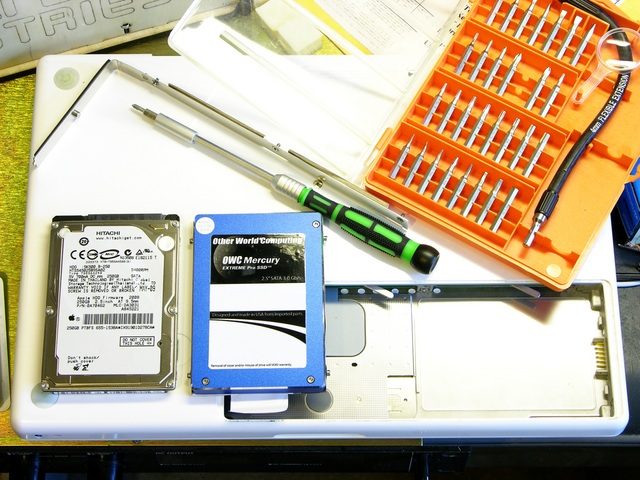A couple of weeks ago, I had my MacBook plugged in and open, but idle for a while, so it parked the hard drive. When I came back and hit a key to wake it, it started saying, “ting wssh wssh wssh.” This is not the kind of language I like my computers to use. The hard drive hasn’t spun up since.
Cort had told me of his impressive performance boosts after upgrading his MacBook to a solid-state drive (SSD) and I’d been interested anyway, so I took advantage of his research and ordered a 115G Other World Computing Mercury Extreme Pro for $230.
It shipped promptly and I swapped drives that weekend. The rubber shock rails in the MacBook had come loose, so I wasn’t able to slide the old drive out and the new one in through the battery compartment and ended up dismantling the entire MacBook case bottom to make the switch.
I had to reinstall the OS and all of my applications; but fortunately I keep a personal wiki with the download links and installation instructions for all the software I run and instructions to duplicate every configuration change I make to every built-in and third-party application, so reinstallation was a breeze. Also fortunately, I had a synchronized copy of most of my work, so I lost very little data.
The new SSD is just unbelievably fast. Installing apps now happens in the blink of an eye rather than the drag of a progress bar. The boot sequence is still perceptible but the login screen pops up before I’m even quite ready for it. OpenOffice launches so quickly I hardly have time to take a bit of a sandwich, much less go make one.

Did you do any erase block alignment of the partitions/filesystems, or is that taken care of by the mac os installer?
Robert, assuming you’re referring to the new SSD, I didn’t do anything special. The OS X installer creates (as far as I can tell) a single disk partition consuming the entire drive; I just let it do its thing.
I did run a single-pass zeroing of the new drive before installing.
Say more about what you have in mind?
At least on linux it seems necessary to align the partition/filesystem as such that the logical blocks match with the rather large write/read/erase blocks used in the SSD. The same is true for the new TB class disks that don’t use 512B sectors, but 4k ones. If you have your system write e.g. 3 of its ‘blocks’ and the end of that doesn’t align with the blocks on the disk, you’ll have a read/modify/write operation because of the ‘overshoot’.
Also if the blocks don’t line up the the large (128k or so) erase blocks of the SSD, it may happen that the device can’t free a chunk, because of just a few bits overhanging from a previous block.
I don’t know if it’s clear what I’m trying to say
I’ve read that if you don’t do it (I didn’t with my SSD), the thing will get slower after time.
Remember to enable TRIM, lest your SSD performance decrease with time! http://osxdaily.com/2011/03/27/enable-trim-ssd-mac-os-x-10-6-7/